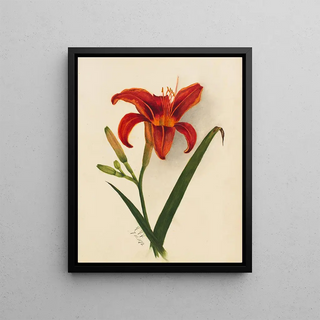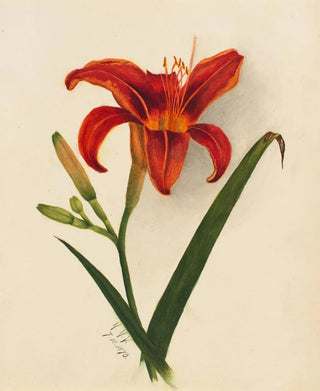Art print | Lis - Mary Vaux Walcott


View from behind

Frame (optional)
Reproduction Lis - Mary Vaux Walcott – Captivating Introduction
In the rich and diverse world of botanical art, the "Lis - Mary Vaux Walcott" art print stands out for its delicacy and striking realism. This piece, which beautifully illustrates the ephemeral beauty of flowers, invites viewers to immerse themselves in a universe where nature is celebrated with unparalleled precision. Mary Vaux Walcott, as an artist and naturalist, masterfully captured the very essence of flora, and this work is a perfect example. The depiction of the lily, with its elegant petals and vibrant colors, evokes a sense of freshness and vitality, allowing everyone to feel the intrinsic beauty of nature.
Style and uniqueness of the art print
The strength of "Lis - Mary Vaux Walcott" lies in its distinctive style, which combines scientific meticulousness with artistic sensitivity. Every detail is carefully rendered, from the veins of the petals to the subtle nuances of color, creating a harmonious composition that draws the eye. The artist employs painting techniques that highlight the texture and transparency of the flowers, giving the art print an almost photographic depth. This attention to detail reflects a passion for botany, where each element is chosen with care to faithfully represent natural beauty. The work is not merely a simple illustration; it tells a story, that of a meeting between art and science, where each lily becomes a symbol of the richness of biodiversity.
The artist and their influence
Mary Vaux Walcott, beyond her undeniable talent, is an emblematic figure of the botanical art movement in the early 20th century. Her career is not limited to painting; she is also recognized for her contributions to conservation and scientific education. As a member of the American Society of Botanists, she worked to promote understanding and appreciation of plants. Her commitment to nature is evident in her works, which are both artistic testimonies and scientific documents. Walcott's influence extends beyond her era, inspiring many artists and naturalists to explore the relationship between art and nature. Her ability to merge these two worlds has helped redefine

Matte finish

View from behind

Frame (optional)
Reproduction Lis - Mary Vaux Walcott – Captivating Introduction
In the rich and diverse world of botanical art, the "Lis - Mary Vaux Walcott" art print stands out for its delicacy and striking realism. This piece, which beautifully illustrates the ephemeral beauty of flowers, invites viewers to immerse themselves in a universe where nature is celebrated with unparalleled precision. Mary Vaux Walcott, as an artist and naturalist, masterfully captured the very essence of flora, and this work is a perfect example. The depiction of the lily, with its elegant petals and vibrant colors, evokes a sense of freshness and vitality, allowing everyone to feel the intrinsic beauty of nature.
Style and uniqueness of the art print
The strength of "Lis - Mary Vaux Walcott" lies in its distinctive style, which combines scientific meticulousness with artistic sensitivity. Every detail is carefully rendered, from the veins of the petals to the subtle nuances of color, creating a harmonious composition that draws the eye. The artist employs painting techniques that highlight the texture and transparency of the flowers, giving the art print an almost photographic depth. This attention to detail reflects a passion for botany, where each element is chosen with care to faithfully represent natural beauty. The work is not merely a simple illustration; it tells a story, that of a meeting between art and science, where each lily becomes a symbol of the richness of biodiversity.
The artist and their influence
Mary Vaux Walcott, beyond her undeniable talent, is an emblematic figure of the botanical art movement in the early 20th century. Her career is not limited to painting; she is also recognized for her contributions to conservation and scientific education. As a member of the American Society of Botanists, she worked to promote understanding and appreciation of plants. Her commitment to nature is evident in her works, which are both artistic testimonies and scientific documents. Walcott's influence extends beyond her era, inspiring many artists and naturalists to explore the relationship between art and nature. Her ability to merge these two worlds has helped redefine






